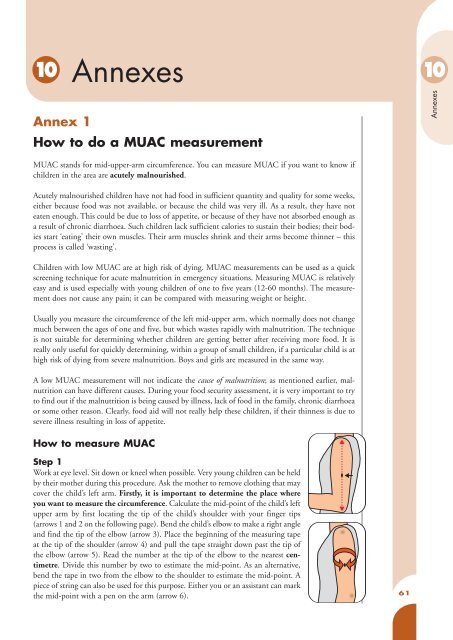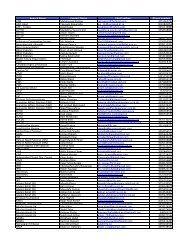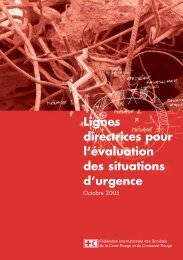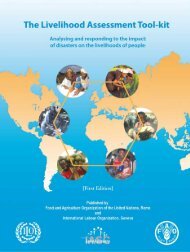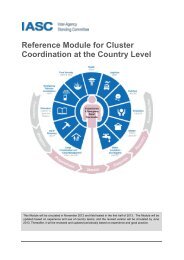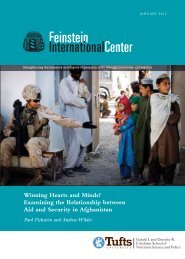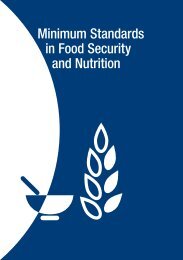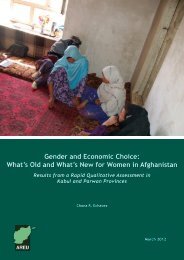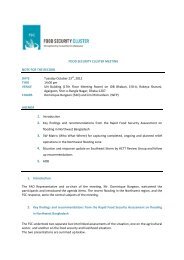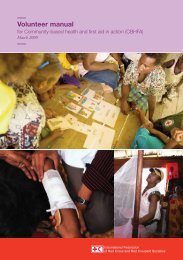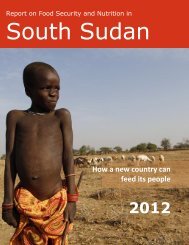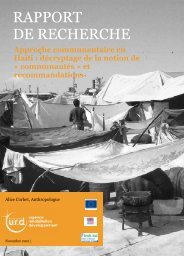Global food security assessment guidelines: A step-by - International ...
Global food security assessment guidelines: A step-by - International ...
Global food security assessment guidelines: A step-by - International ...
You also want an ePaper? Increase the reach of your titles
YUMPU automatically turns print PDFs into web optimized ePapers that Google loves.
10Annexes10Annex 1How to do a MUAC measurementAnnexesMUAC stands for mid-upper-arm circumference. You can measure MUAC if you want to know ifchildren in the area are acutely malnourished.Acutely malnourished children have not had <strong>food</strong> in sufficient quantity and quality for some weeks,either because <strong>food</strong> was not available, or because the child was very ill. As a result, they have noteaten enough. This could be due to loss of appetite, or because of they have not absorbed enough asa result of chronic diarrhoea. Such children lack sufficient calories to sustain their bodies; their bodiesstart ‘eating’ their own muscles. Their arm muscles shrink and their arms become thinner – thisprocess is called ‘wasting’.Children with low MUAC are at high risk of dying. MUAC measurements can be used as a quickscreening technique for acute malnutrition in emergency situations. Measuring MUAC is relativelyeasy and is used especially with young children of one to five years (12-60 months). The measurementdoes not cause any pain; it can be compared with measuring weight or height.Usually you measure the circumference of the left mid-upper arm, which normally does not changemuch between the ages of one and five, but which wastes rapidly with malnutrition. The techniqueis not suitable for determining whether children are getting better after receiving more <strong>food</strong>. It isreally only useful for quickly determining, within a group of small children, if a particular child is athigh risk of dying from severe malnutrition. Boys and girls are measured in the same way.A low MUAC measurement will not indicate the cause of malnutrition; as mentioned earlier, malnutritioncan have different causes. During your <strong>food</strong> <strong>security</strong> <strong>assessment</strong>, it is very important to tryto find out if the malnutrition is being caused <strong>by</strong> illness, lack of <strong>food</strong> in the family, chronic diarrhoeaor some other reason. Clearly, <strong>food</strong> aid will not really help these children, if their thinness is due tosevere illness resulting in loss of appetite.How to measure MUACStep 1Work at eye level. Sit down or kneel when possible. Very young children can be held<strong>by</strong> their mother during this procedure. Ask the mother to remove clothing that maycover the child’s left arm. Firstly, it is important to determine the place whereyou want to measure the circumference. Calculate the mid-point of the child’s leftupper arm <strong>by</strong> first locating the tip of the child’s shoulder with your finger tips(arrows 1 and 2 on the following page). Bend the child’s elbow to make a right angleand find the tip of the elbow (arrow 3). Place the beginning of the measuring tapeat the tip of the shoulder (arrow 4) and pull the tape straight down past the tip ofthe elbow (arrow 5). Read the number at the tip of the elbow to the nearest centimetre.Divide this number <strong>by</strong> two to estimate the mid-point. As an alternative,bend the tape in two from the elbow to the shoulder to estimate the mid-point. Apiece of string can also be used for this purpose. Either you or an assistant can markthe mid-point with a pen on the arm (arrow 6).61


